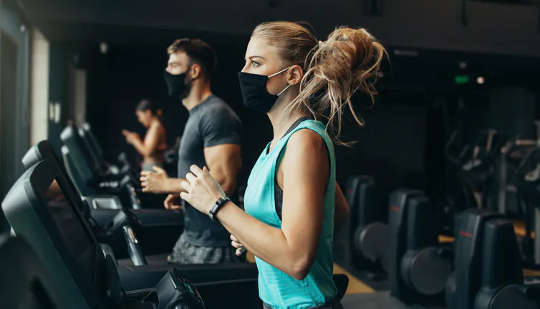
Tendon and muscle injuries are the most common. DuxX/ Shutterstock
After months in lockdown, gyms in England reopened on April 12, 2021. Many have already eagerly returned with plans to get back to their old fitness routines. But while it may be tempting to go straight back to what you used to do, this could result in an injury – which is why it’s better to ease into training after months off.
Injuries happen when training load exceeds tissue tolerance – so basically, when you do more than your body is capable of. Fatigue, muscle-tendon strength, joint range of motion, and previous injury to the tissue can all increase the likelihood of sustaining an injury.
The most common injuries associated with excessive training loads are tendinopathies and strains. Tendinopathy describes when tendons – the tissue connecting your muscles to your bones – have failed to repair properly from previous damage. Common tendinopathies occur in the buttock, proximal hamstring (thigh) and Achilles, while the most common muscle strains happen in the shoulder and knee. But understanding of how our body changes in response to training can help us reduce injury risk when we return to the gym.
Exercise is stressful to our body. As such, a training session “alarms” various body systems (including the muscular-skeletal and cardio-respiratory systems), disturbing the body’s normal state. These systems subsequently respond to the stress by developing resistance and adapting beyond their current capacity – often referred to as supercompensation. Essentially, this process leads to us becoming stronger or fitter.
Get The Latest By Email
Importantly, adaptation occurs after training and requires time. If the body is unaccustomed to the type of training or has not adequately recovered from a previous training session, then this can lead to injury or illness. This is why it’s key to increase training stress gradually over time and ensure you are well recovered between training sessions.
It’s also important to remember that after a long break, even if you can still do the same amount of training as before, the stress on your body could much greater. So for example, let’s say you were able to perform a 20-minute run of the treadmill at 10km/hour prior to lockdown with an average heart rate of 125 beats per minute. Enthusiastically, you complete the same run after lockdown – but your current heart rate now beats an average of 160 beats per minute.
This shows us that while the external training load (the exercise, as described in your training plan) is the same as it was pre-lockdown the body’s response to the training, the internal training load is much greater. In this case a higher heart rate indicates greater stress on your cardio-respiratory system. So, the same session has become more tiring.
And if you’ve moved less throughout lockdown, it’s possible your lower limb strength and coordination has suffered. This means you’ll be less able to cope with the impact of running, placing greater stress on your joints, muscles, and bones. Without better or longer recovery, this accumulation of stress could lead to injury within a few weeks of training.
Reducing risk
To help avoid common injuries a cautious approach to high-impact activities such as jumping may be beneficial, as well those that require muscle lengthening, such as lowering a weigh. While these activities benefit muscular and skeletal health and should be encouraged for most people, they are still challenging to perform and you should spend time developing proper technique before lifting heavier weights or doing more vigorous exercises.
Here are a few other things you can do to avoid injuries as you return to the gym:
-
Warm-up Warming up has been consistently shown to improve performance and reduce injury. A good warm-up should steadily raise your heart rate and prepare your body for the exercise you are about to perform. Consider including exercises that mobilise key joints and that engage your major muscle groups, such as body weight squats and lunges.
-
Monitor how your training feels Monitoring your internal load – your body’s response to a training session – is a great way to help you avoid doing too much. You can use ratings of perceived exertion (RPE) scales, such as Borg’s CR-10 scale, which measures exertion on a scale from one to ten. This way you can rate your overall exertion for different training activities to help you determine how hard your have trained.
-
Do high-intensity interval training (HIIT) Short, intense workouts are popular and can be a safe and effective way of improving health and fitness. While they are high intensity, they’re also low in duration, so the overall training load is usually easily managed. However, consider choosing a low-impact option initially (such as cycling), as high intensity – and high-impact – exercises could increase injury risk after some time off.
-
Do strength training Doing strength training, such as lifting weights, two to three times each week can prepare our tissues for more complex activities, as well as having a wide ranging health benefits such as improving mental health, preventing falls and reducing mortality.
Other tips include staying hydrated, wearing appropriate clothing and footwear, and taking enough time to recover – with a focus on sleep and good nutrition. Recovery strategies like foam rolling, compression garments and even cold water therapy might help for some people, but the best way to recover is to focus on sleeping and eating.
Of course, you shouldn’t let the risk of injury put you off exercising. Taking things slowly at first will ensure you’re less likely to develop an injury. Most importantly, enjoy exercise, and develop a routine which benefits your lifestyle.
About the Authors
Matthew Wright, Lecturer in Biomechanics and Strength and Conditioning, Teesside University; Mark Richardson, Senior Lecturer in Sports Rehabilitation, Teesside University, and Paul Chesterton, Associate Professor, Sports Therapy and Rehabilitation, Teesside University
books_exercise
This article is republished from The Conversation under a Creative Commons license. Read the original article.







